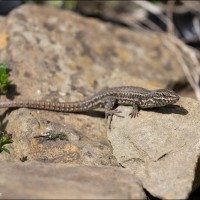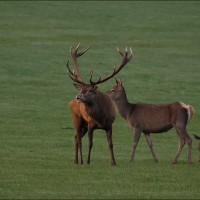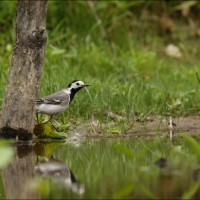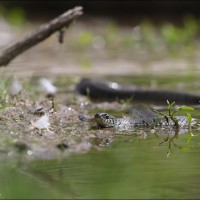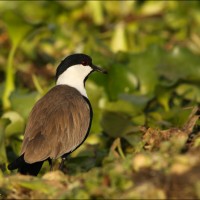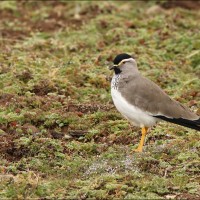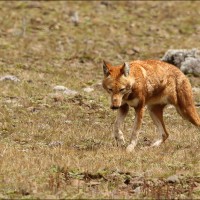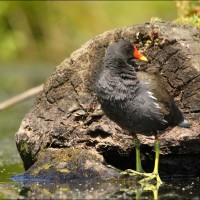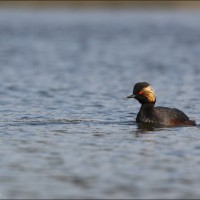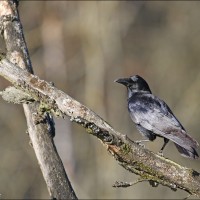Welcome
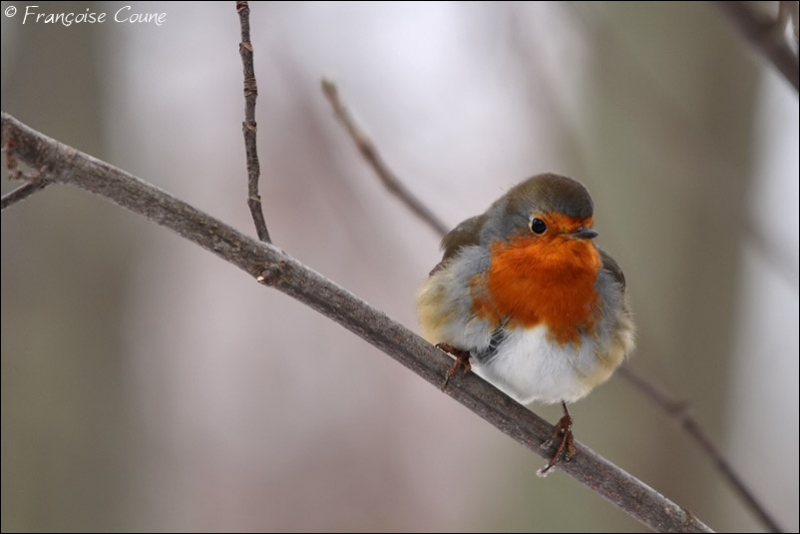 As Yann Arthus Bertrand puts it so well: "In photography, it is not the photographer who is important"
As Yann Arthus Bertrand puts it so well: "In photography, it is not the photographer who is important"
I hope through my photos to succeed in making you discover the beauty of Nature and make you understand that it is there for us and that it is essential to respect it.
Photo of the week
Common Jay
The Common Jay (Garrulus glandarius) is a species of bird in the Corvidae family. It is recognizable by its colorful plumage, striped with black and white on the head, whose feathers can stand up (erectile crest). Its beak is extended by a black band under the eye which gives the impression that it has some kind of black whiskers. Its body is pinkish brown above and lighter brown below, its tail is black, its rump and underbelly white, its primaries of the wings are bright blue and black.
Its diet is omnivorous: like tits and sparrows, it feeds on larvae and insects, but it also has a vegetable diet (acorns, nuts, chestnuts...). He is particularly fond of the acorns of the oaks which he hides for the winter. Like all corvids, and many other forest species6, it is occasionally a predator of other birds (especially in spring); it does not hesitate to attack the nests of small birds to eat their eggs or even chicks (more rarely). He can steal an egg in seconds. This is the origin of its reputation as nest raiders.
It lives throughout Europe, except for the most northern areas (Iceland, northern Ireland, Scotland and notable parts of northern Norway, Sweden, Finland and Russia), in North Africa North and throughout mainland Asia. In the coldest areas of its habitat (Sweden, Norway and Poland), the populations of the jay of the oaks migrate, in autumn, towards more southern regions.
It is a "lookout" bird whose shrill cry is reputed to alert its congeners, but also some of the animals of the undergrowth and the forest, at the approach of a predator or an intruder (such as a walker ). The highly interspecific value of the Jay's calls justifies the term "sentinel of the forest" attributed to this species.
Source: Wikipedia
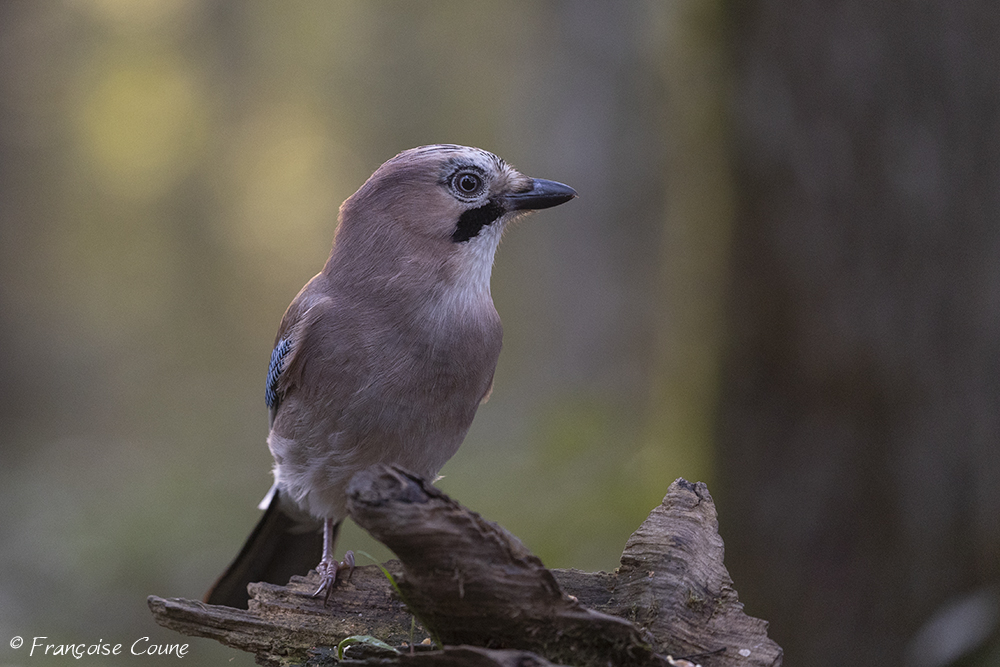
Common Jay (Garrulus glandarius)
Rochefort (Belgium)
November 2022
-
Nazca Booby
Nazca Booby
The Nazca Booby (Sula granti) (taking its name from the province of Nazca), is a species of seabird belonging to the Sulidae family. It is found on islands off Mexico in the north of its range and south to the Galápagos in the southwest. The largest colonies are located in Galápagos (Ecuador) and on the Malpelo Islands off the coast of Colombia.
It is a relatively large bishop and similar in appearance to the Masked Booby. These madmen are elegantly dressed in white. The flight feathers are black and the rectrices gray to black. The black mask, which starts from the base of the beak and covers the eyes, allows, like the Masked Booby, to recognize it very easily. The eyes are yellow. The beak, with a yellowish tip, is rather orange in the male and pink in the female. Females possess a slightly larger size and weight than males, but the difference is noticeable only in direct comparison.
Juveniles are dark brown above, with white edges and rare white spots. Their underparts are white. They don't really look like adults until they reach the age of three.
It feeds mainly on fish caught in coastal waters, but, if necessary, they can travel over 300 km during the breeding season. It can dive from a height of 30 m but the depths reached are most often 3 to 4 m.The Grant's Booby population is estimated at 50,000 individuals and decreasing. The species is classified as "of minor concern", therefore not yet threatened to date. This bird is sensitive to the "El Niño" phenomenon which leads to a scarcity of food in its usual fishing grounds.
Source: oiseau.net
Photo : Genovesa Island (Galapagos - Ecuador) - July 2022
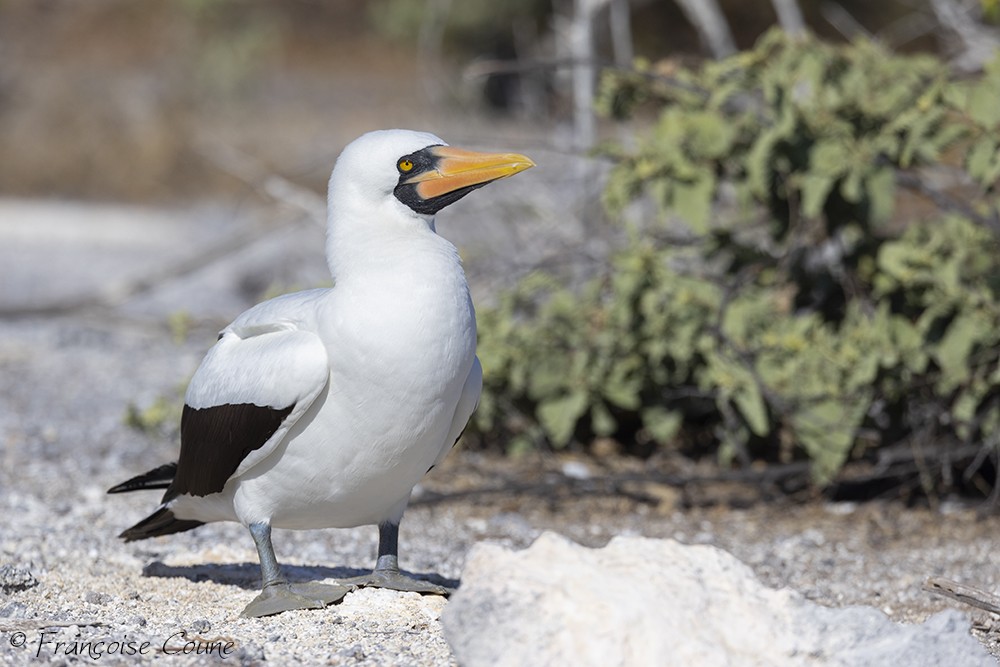
-
Red-footed Booby
Red-footed Booby
The Red-footed Booby (Sula sula) is a species of seabird in the Sulidae family.
This species nests on islands and tropical ocean coasts. It winters at sea.
It is rare to observe this bird far from breeding sites, where it gathers in large colonies. The single egg, pale blue in color, is laid in a nest of branches on a tree. It is brooded by both parents for 44 to 46 days. The young bird may wait up to three months before it can fly for the first time, and up to five months before actually making long flights.
Pairs of red-footed boobies may remain together for several seasons. They practice elaborate greeting rituals, including hoarse cries. The males inflate their blue throat.It is the smallest of the fools, (length: 71 cm / wingspan: 137 cm). He has red legs. The beak and throat are colored pink and blue. There are two types of plumage in this species: white (except the remiges which are black) or brown (except the tail and lower belly which are white, the peaceful form is entirely brown). Both types can coexist.
The sexes are similar, but juveniles are greyish with browner wings and pink legs.
Red-footed boobies are spectacular divers, penetrating water at very high speeds. They feed mainly on small fish and squid. Although agile and powerful in flight, they are clumsy when taking off and landing.
Source: Wikipedia.
Photo : Genovesa Island (Galapagos - Ecuador) - July 2022

-
Wall Lizard
Wall Lizard
The wall lizard (Podarcis muralis) is a species of Lacertilia in the family Lacertidae. This small lizard is native to continental Europe, more precisely to the Italian and Balkan regions. It is widely present in all the countries of Mediterranean or neighboring Europe, but not in the Mediterranean islands. It has been introduced to North America and England.
The genus name Podarcis comes from the Greek ποδάρχις and means "quick-footed", and the species name comes from the Latin mūrālis which means "of the rampart, of the walls".It is present in a wide range of habitats, between sea level and altitudes that exceed 2000 m. In general, it lives in dry, sunny, stony environments with poor vegetation. It likes places sheltered from the wind, with open areas exposed to the sun, and places that are full of holes and cracks, or possible refuges in case of need. So a habitat that meets its major biological imperatives: to warm, to save, to protect, to feed.
It is both a predator and a prey. He is a hunter of insects and other small animals, who is formidable in the art of the lookout. It feeds on spiders, lepidoptera (butterflies, caterpillars, moths or moths), orthoptera (locusts, crickets), earthworms, small slugs, aphids, diptera (flies, mosquitoes, etc.) , beetles (beetles, ladybugs...) and even hymenoptera (bees, wasps, ants...)
Source: Wikipedia.
Photo : Liège (Belgium) - April 2022

-
Red Deer
Red Deer
The red deer (Cervus elaphus) is a large cervid found in the temperate forests of Europe, North Africa, North America and Asia. Its name is a pleonasm because “élaphe” already means “deer” in Greek.
The female is the doe, the cub is the fawn. Then, from 6 months to 1 year, it is called "heir" if it is a male, the female keeps the name fawn for up to a year. From 1 year to 2 years old, the young male is called "brag" with two large dry antlers and the female "bichette".
It is a crepuscular and nocturnal species (or which has become so by adapting to hunting pressure, as it has probably become forest while being more adapted to semi-open or open environments).
The species is gregarious. The females (hinds) gather in herds with a home range of 2,000 to 5,000 ha. The males live with them during the mating season (the rut). A single male can be accompanied by a herd of up to sixty hinds.
Males and females live separately from December to August and meet for a fertilization period that extends in temperate Europe from September 15 to October 15. The rut, marked by the hoarse and resounding cry of the male (the slab) occurs in late summer or early fall, and lasts for about a month, but deer beating can still be heard until mid -November. The cry of the slab is a roar and a bellow and can be heard several kilometers away.
Source : wikipedia

-
Gray Wagtail
Gray wagtail
The Gray Wagtail (Motacilla alba), also called Hochequeue gris, is a species of small passerine bird in the same family as the pipits and the sentinel. This species breeds in most of Europe and Asia, as well as parts of North Africa. It is sedentary in the softest part of its habitat and migrates south in the other cases. It is considered a national emblem in Latvia.
She lives in open spaces, often near homes and water points. It nests in the interstices of stone walls, under roofs, in bridges or in tree holes. Its nest is made of straw, leaves and roots.
It is an insectivore feeding mainly on flies, mosquitoes and ants. It can peck insects on the ground, or capture them in flight.
Source : wikipedia
Photo : Colonster (Liège - Belgium) - July 28, 2020

-
Fly Agaric
Fly Agaric
The Fly Agaric or Fly Amanita (Amanita muscaria), is a species of basidiomycete fungi of the Amanitaceae family. Toxic and psychotropic, it is one of the many representatives of the Amanita genus, and certainly the best known. Native to temperate regions of the northern hemisphere, it was accidentally introduced to many countries in the southern hemisphere, mainly as a symbiote of cultivated pines, and has become cosmopolitan. It associates with the roots of various deciduous and coniferous trees.
Poisoning by Fly Amanita is very rarely fatal. This species is best known for being hallucinogenic. Its main psychoactive constituent is muscimole. The fungus gave its name to muscarine, a poison of the parasympathetic nervous system that it contains in very small quantities, and to a type of cell receptor, muscarinic receptors.
It is a large sporophore, with a white stipe and white-bladed hymenium, with a cap covered with a dark red cuticle, dotted with white dots.
The vernacular name of the mushroom derives from the Latin fungus muscarum, "mushroom of flies". It is common to several European languages Note 1 and arises from its use as an insecticide, when it is mixed with milk. This practice would have been used in Germany, in certain Slavic cultures, in the region of the Vosges in France, and in Romania. In reality, the fly agaric does not kill flies but puts them to sleep.
The Fly Bug develops a large, easily identifiable sporophore. It emerges from the ground in the appearance of an egg, wrapped in the fluffy tissue of the universal veil. When fully ripe, the hat is usually between 8 and 20 centimeters in diameter. The red color fades under the effect of rain and in older mushrooms. After emerging from the ground, the hat is covered with numerous white warts in the shape of pyramids. They are vestiges of the universal veil.
Photo : Bois de la Vecquée (Seraing - Belgium) - September 21, 2020

-
Grass snake
Grass Snake
The Grass Snake (Natrix natrix), now to be differentiated from the Swiss Snake (Natrix helvetica), is a species of snakes of the Natricidae family, which lives beyond the Rhine and in northern Europe. It can sport colors ranging from gray to black, brown and greenish, but it is generally recognizable by the light pattern it wears on the nape of the neck, which has given it its vernacular name. Its size varies from 65 cm to more than 1.40 m, the females being larger than the males.
It is, in most of its range, subservient to wetlands and is found near water. In northern Europe, it is found more in the plains and can even be seen in forest or in dry meadows. She has mainly diurnal habits even if she happens to go out at night, especially to hunt. It is an active snake that can move quickly, both on land and on the water surface. It can remain in apnea for up to thirty minutes underwater.
It feeds almost exclusively on amphibians, in particular frogs, toads, tree frogs and newts, more rarely salamanders.
It is aglyph and is not poisonous. It swallows its prey alive, without suffocating them. It is able to swallow prey larger than its head, its jaws being able to widen sharply during swallowing.Photo : Colonster (Liège - Belgium) - July 28, 2020

-
Spur-winged Lapwing
Spur-winged Lapwing
The Spur-winged Lapwing (Vanellus spinosus) is a species of wading birds in the Charadriidae family.
The bird owes its name to a spur hidden in each of its wings that it would sometimes use to defend itself when it feels threatened.
Its range extends across the north of sub-Saharan Africa, the Nile valley and more dissolved in the Middle East and Turkey (where it is migratory).
Its population is declining in its boreal range, but it remains abundant in Africa where it can be seen and heard by its scream, practically in all humid regions.
It lives mostly in marshes and shallow freshwater bodies.It feeds on insects and other small invertebrates that it pecks on the ground.
Photo : Lake Ziway (Ethiopia) - November 05, 2019

-
Spot-breasted Lapwing
Spot-breasted Lapwing
The Spot-breasted Lapwing (Vanellus melanocephalus) is a species of bird in the family Charadriidae. It is endemic to the Ethiopian highlands.
Pairs or small flocks are locally frequent to common in highland grasslands and moorland, often in damper areas or near pools, at 2400-3800m
Photo : Bale Mountain (Ethiopia) - November 08, 2019

-
Ethiopian Wolf
Ethiopian Wolf
The Ethiopian wolf (Canis simensis), also known as the Simien jackal or Simien fox, is a canid native to the Ethiopian Highlands. It is similar to the coyote in size and build, and is distinguished by its long and narrow skull, and its red and white fur. Unlike most large canids, which are widespread, generalist feeders, the Ethiopian wolf is a highly specialised feeder of Afroalpine rodents with very specific habitat requirements. It is one of the world's rarest canids, and Africa's most endangered carnivore.
The species' current range is limited to seven isolated mountain ranges at altitudes of 3,000–4,500 m, with the overall adult population estimated at 360–440 individuals in 2011, more than half of them in the Bale Mountains.
The Ethiopian wolf is listed as endangered by the IUCN, on account of its small numbers and fragmented range. Threats include increasing pressure from expanding human populations, resulting in habitat degradation through overgrazing, and disease transference and interbreeding from free-ranging dogs. Its conservation is headed by Oxford University's Ethiopian Wolf Conservation Programme, which seeks to protect wolves through vaccination and community outreach programs.
Source : wikipedia
Photo : Bale Moutain (Ethiopia) - November 08, 2019

-
Common Moorhen
Common Moorhen
The Common Moorhen (Gallinula chloropus) or more simply hen of water, is a species of bird belonging to the order of Gruiformes and to the family of the rallidae.
It is very common in ponds and ponds, as well as in rivers where the vegetation is sufficiently dense.
It is easily recognized by its red beak with yellow tip. Its plumage ranges from dark blue to black, with brown wings and a white patch on either side of the rump. Its legs are yellow-green and are not webbed.The range of this species is very large, covering the Americas, the Antilles, Europe and Africa as well as the Malagasy region, South Asia and some Pacific islands (see subspecies for more details).
The water hen is a relatively shy bird when not chased, and can therefore be observed quite easily, even in cities where it frequents canals and bodies of water in public gardens. This has earned it, unlike more discreet species, to receive a vernacular name in most of the languages spoken in its area of distribution.
This bird is represented on more than twenty stamps, in particular by the postal authorities of the Caribbean region and of several European countries.
Source: wikipedia
Photo: Colonster (Liège - Belgium) - July 06, 2019

-
Poppy
Poppy
The poppy (Papaver rhoeas) is a species of dicotyledonous plants of the family Papaveraceae, native to Eurasia.
It is an annual herb, very abundant in the grounds freshly moved from spring, which is distinguished by the red color of its flowers and by the fact that it often forms large colored carpets visible from afar. It belongs to the group of so-called messicole plants because it has been associated with agriculture since very ancient times, thanks to its biological cycle adapted to cereal crops, flowering and setting seeds before harvest. Very common in various European countries, it has greatly decreased due to the widespread use of herbicides and the improvement in the cleanliness of cereal seeds.
The poppy prefers freshly stirred soils: cultivated fields, especially winter cereals, but also spring ones (once messicole plant that herbicides have often hunted). It thus returns spontaneously in the least treated areas (at the entrance to fields, along hedges), road edges, embankments or in very diverse open areas, already disturbed (embankments, road shoulders, constructions in agricultural areas , vacant lots…).
Flowering takes place mainly in spring and summer, between April and August (in the northern hemisphere), but sometimes a second flowering occurs in autumn, towards the end of September.
The poppy contains in all its parts latex in which there are various alkaloids, the main one being rhoeadine, but unlike the sleeping poppy, it does not contain morphine.
The poppy is probably native to the east of the Mediterranean basin (southern Europe, North Africa and the Middle East). The plant, associated with crops, especially cereals, has spread and naturalized throughout Europe and temperate Asia, as well as in North America.
Source: wikipedia
Photo: Kochersberg (Alsace - France) - May 31, 2019

-
Glanville fritillary
Glanville fritillary
The Glanville fritillary (Melitaea cinxia) is a species of lepidoptera (butterflies) belonging to the family of Nymphalidae.
It is a butterfly with an orange-yellow top, bordered, ribbed and ornamented with brown with a posterior line of brown dots in the hindquarters centering orange-yellow spots. The reverse is with bands of orange-yellow and creamy white scalloped, delimited by thin brown lines.
The black caterpillar is thorny with its dark red head and legs.It winters as a young caterpillar in a silk canvas.
It flies in one generation between the end of April and the end of June or two generations in May June and then August September.It is present in North Africa, in almost all of Europe, the Middle East, southern Siberia and Mongolia.
This species, like almost all butterflies is in decline in Europe, probably due to the widespread use of insecticides that contaminate water, air and soil, but also and in particular due to the ecological fragmentation of its environments.
Source: wikipedia
Photo: Montagne St-Pierre (Lanaye - Belgium) - May 22, 2019

-
Common Shelduck
Common Shelduck
The Common Shelduck (Tadorna tadorna) is a species of bird belonging to the Anatidae family. Like the other species of the genus Tadorna, it has intermediate characteristics between those of geese (low sexual dimorphism between males and females, participation of the male in brood care) and those of ducks (morphology, voice). This intermediate position is confirmed by recent phylogenetic studies.
It is a Palearctic species whose distribution is divided into two main areas, one on the sea shores of north-west Europe and the other in the semi-arid regions of central Asia.
This shelduck is dedicated to Pierre Belon (1517-1564), a great French zoologist of the Renaissance. The term shelduck, carried by several species, is of uncertain origin. On the other hand, it was used in French from the 16th century.
This bird measures between 58 and 67 cm in length and 100 to 120 cm in wingspan.
The male has a greenish black head, a red beak with a caruncle of the same color, an important visual sexual character during courtship. It carries a reddish pectoral band from which a dark ventral stripe leaves, white wings with the scapulars and the black flight feathers (marked with a green mirror) and the rest of the white body. The female is almost as colorful as the male (characteristic allowed by its brooding under cover, in burrows) and does not have a caruncle on the beak, often more marked with black. Adults of both sexes have pink legs. The chicks are covered with a dark brown and white down. The young are distinguished from adults by the wing covers strongly marked with black brown, the absence of a red pectoral band, the whitish face and throat, the pink beak and the gray legs.
This bird inhabits coastal (estuaries, mudflats, brackish or salt lakes) and continental wetlands.
The diet of the Shelduck is mainly composed of hydrobia but this bird can also eat other prey such as crustaceans.
The world population is between 580,000 and 710,000 individuals (including more than 300,000 for the Western Palearctic), the species is not threatened.
Source: wikipedia
Photo: Hollogne-sur-Geer (Belgium) - April 15, 2019

-
Black-necked Grebe
Black-necked Grebe
The Black-necked Grebe (Podiceps nigricollis) is a species of bird in the podicipedidae family. It is the most sociable of all grebes, but also the one with the world's largest population.
It has an intermediate size between the Great Crested Grebe and the Little Grebe, it measures 28 to 34 cm. Its wing has a length of 12.4-13.9 cm for a total wingspan of 50 to 60 cm. Its beak is generally 2-2.6 cm; it is longer in the male (generally more than 2.4 cm) than in the female (generally less than 2.3 cm). Its weight varies from 213 to 402 g.
During the breeding period, it is recognizable thanks to the fiery roux of its flanks but also thanks to the tufts of golden feathers which can unfold in fans on the sides of its head. The red iris is very clearly visible on the entirely black background of the head. The neck and back are also deep black. The black cap of the head is often more rounded than in other grebes.
Winter plumage is dull. The back, the back of the neck and the cap are black, the flanks, the belly, the chest, the throat and the cheeks are of a more or less light gray, but the bottom of the cheeks is white.More sociable than other grebes, it generally nests in colonies of up to a hundred pairs, often in the company of colonies of Black-headed Gulls or Terns with mosquito.
It emits trills (bibibib) and whistles (houiiti) very acute in summer (to listen to its cry, see on the page of reference 4 opposite. In winter, it is generally silent.
In summer, it feeds on insects caught on the surface, but also on aquatic insects (adults and larvae), tadpoles, small fish, molluscs and small crustaceans captured by diving and swimming underwater. In winter, its diet is more strictly fish-eating. It swallows its prey underwater, unlike the Little Grebe which consumes its prey on the surface.
In summer, it frequents medium-sized freshwater bodies, abandoned settling basins and clay pits - often in the company of giant gull colonies. It prefers bodies of water with abundant vegetation on its banks and abundant aquatic fauna. In winter it is most often found in lakes, large ponds and on estuaries but also on the sea coast. It often mixes with other grebes during the wintering
It is a partial migrant, because the populations of southern Europe, Asia and the USA can be resident all year round. The South African subspecies P. nigricollis gurneyi does not migrate at all.
Source: wikipedia
Photo: Hollogne-sur-Geer (Belgium) - April 15, 2019

-
Herring Gull
Herring Gull
The Herring Gull (Larus canus) is a species of seabird in the family Laridae. He lives in the north of Asia, Europe and in the northwest of North America.
It is a small-sized gull (39 to 42 cm in length for a wingspan of 108 to 119 cm and a mass of 335 to 450 g), since it is barely larger than the members of the genus designated vernacularly under the name of seagulls.
It is distinguished from many other species of gulls (Herring Gull or Gypsy Gull, among others) by the absence of red spots on the beak. This, entirely greenish yellow, also has a narrow dark bar in winter.
In breeding plumage, the adult has the coat and a large part of the bluish ash gray wings, the head, the neck, the underside of the body and the tail white, while the orbital circles are red. The primary flight feathers are partly black with the gray base and a white spot towards their end, the secondary gray with white tip. Full moult takes place from June to October. The bird then presents its internuptial plumage with gray-brown streaks on the head and neck. Partial moult occurs from March to May.
The Herring Gull consumes various prey: many species of lamellibranchs (cockles, common mussel, Ensis directus, Spisula solida, etc.), earthworms, etc. Capable of elaborate behaviors, to provoke the earthworm emergence, it hits the ground with its webbed legs alternately while remaining on the spot; sometimes it turns on itself so as not to let escape any prey.
It can also kleptoparasitize other birds, in particular shorebirds: Oystercatcher, Crested Lapwing, Black-tailed Barge and Sanderling; but also grebes.
Source: wikipedia
Photo: Lanaye (Belgium) - February 17, 2019

-
Carrion Crow
Carrion Crow
The Carrion Crow (Corvus corone) is a species of passerine bird in the family Corvidae.
It is a bird that is commonly found in much of Europe and Asia, mainly in the countryside, but also in urban areas (see distribution map).
It measures 44 to 52 cm long and weighs 383 to 604 grams for females and 418 to 675 grams for males. The majority of birds weigh between 540 and 650 g. Its wingspan is 88 to 104 cm.
It has a shiny black dress, black legs, a dark gray to black beak, stocky and tapered, which differentiate it from its close relative, the Hooded Crow and its larger and much rarer cousin, the Common Raven. The black crow is larger than the rook crow. The two sexes are identical (no sexual dimorphism). Its cry is hoarse and powerful, it is said to shout, crackle, babble, crow or grease.She lives in territorial pairs when she is an adult, in a gang for juveniles. Its nesting period extends from March to June: the nest, consisting of twigs, is most often installed on the fork of a tree, but we also see it in metal structures and sometimes even on the ground. There is only one laying per breeding season, counting up to 6 eggs.
Very well adapted to temperature differences, and when living near areas inhabited by humans (more easily find food there), some of them decide not to migrate south in winter. In Canada and Russia for example, where the temperature can drop to -40 degrees Celsius in winter, this bird can be observed throughout the year.
It feeds mainly on corpses, small animals (by the sea, it is able to feed on shells) and, in areas of human habitation, waste. It also loots other nests.
In the countryside, she fears the neighborhood of the man who often seeks to destroy her, ignoring the services she renders to her as well as to the environment and nocturnal raptors (who use their nests) and only blaming her for the damage that 'it can cause crops, but in town it has gotten used to it perfectly, approaching very close to those who feed it.Source: wikipedia
Photo: Colonster (Liège - Belgium) - February 24, 2019

-
Mallard Duck
Mallard Duck
The mallard duck (Anas platyrhynchos), or Mallard duck in Canada, is a species of birds of the order Ansériformes, the family of Anatidae and the subfamily Anatines. It is certainly the best known and recognizable of all ducks, due to the existence of domestic duck breeds from this species.
It measures 50 to 68 centimeters long for an average weight of 1.2 kilograms for the male and 1.1 kilograms for the female and a wingspan of 78 centimeters to 1 meter.
The male of wild populations is easily recognizable, during the nuptial period, by its head of a brilliant green (from where its name). The rest of the plumage is gray-brown to white, with a blue-violet wing mirror; the bill is yellow. After the nuptial period, with the approach of summer, it moults and takes its eclipse plumage (beige in color similar to that of juveniles and females) and loses its flight feathers. He then lives in the reeds and tall grass. About one to two months later, the male resumes its breeding plumage.
The female has a brown bill and duller plumage (beige speckled with brown). This resembles that of the Black Duck although generally of a lighter shade. The male's beak is yellowish or greenish, more or less stained with black, and its legs are orange-red. Male, female and juvenile have a blue-violet iridescent mirror bordered by white bars on the wings. The head of the ducklings is more orange and it has a cap, the back, a bar on the eye and the dorsal side of the wings dark brown, the white chest. Domestic breeds can be completely white, black, green like the Cayuga, or similar in appearance to the wild population like the Campbells. Domestic ducklings are most often completely yellow.
It belongs to the group of dabbling ducks, those who prefer to feed on the surface, or at shallow water depth, advancing with circular and alternating legs: it plunges its head into the water and rocks forward, which allows it to reach the bottom of the water with its beak. He also ventures on the meadows to graze. It is omnivorous and feeds on fish and herbs, seeds and worms, frogs and insects.
This duck lives in freshwater wetlands, whether in swamps, ponds and lakes or calm rivers, in all temperate and subtropical regions of North America, Europe, Asia, New Zealand, and Australia, from sea level up to 2,000 meters above sea level. It lives on water, and only goes on dry land for nesting and resting. This species is migratory north of its range.
Source: wikipedia
Photo: Colonster (Liège - Belgium) - February 16, 2019






